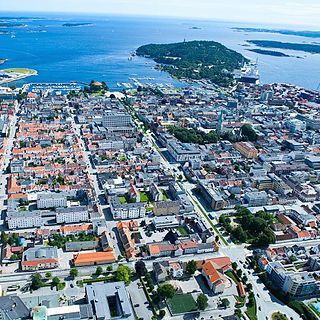
Kristiansand, historically spelled Christianssand and Christiansand, is a city and municipality in Agder county, Norway. It is the fifth largest city in Norway and the municipality is the sixth largest in Norway, with a population of around 112,000 as of January 2020, following the incorporation of the municipalities of Søgne and Songdalen into the new and revised municipality of greater Kristiansand. In addition to the city itself, Statistics Norway counts four other densely populated areas in the municipality: Skålevik in Flekkerøy with a population of 3,526 in the Vågsbygd borough, Strai with a population of 1,636 in the Grim borough, Justvik with a population of 1,803 in the Lund borough, and Tveit with a population of 1,396 in the Oddernes borough. Kristiansand is divided into five boroughs: Grim, which is located northwest in Kristiansand with a population of 15,000; Kvadraturen, which is the centre and downtown Kristiansand with a population of 5,200; Lund, the second largest borough; Søgne, with a population of around 12,000 and incorporated into the municipality of Kristiansand as of January 2020; Oddernes, a borough located in the west; and Vågsbygd, the largest borough with a population of 36,000, located in the southwest.

Sagene is a borough of the city of Oslo, Norway. The area became part of the city of Oslo in 1859. The name Sagene itself is the plural of the Norwegian word for "saw", reflecting all the old industrial mechanical saws powered by the river Akerselva in this area in the 19th and early 20th centuries.

Nordre Aker is a borough of the city of Oslo, Norway.

Southern Norway is the geographical region (landsdel) along the Skagerrak coast of southern Norway. The region is an informal description since it does not have any governmental function. It roughly corresponds to the old petty kingdom of Agder as well as the two former counties of Vest-Agder and Aust-Agder. From New Year 2020, the two counties have been merged into one county, Agder. The total combined area of Vest-Agder and Aust-Agder counties is 16,493 square kilometres (6,368 sq mi). The name is relatively new, having first been used in Norway around 1900.

AS Oslo Sporveier is a defunct municipal owned company responsible for public transport in Oslo, Norway. It was created in 1924 to take over the city's two private tram companies. In 1927 its started with bus transport, including from 1940 to 1968 trolleybuses. Since 1966 rapid transit and from 1985 water buses have also been operated by the company. It was split into two separate companies in 2006; Kollektivtransportproduksjon took over the operation while Oslo Public Transport Administration was responsible for buying the services, fare regulation and marketing. The latter merged into Ruter in 2008, when the Oslo Sporveier brand was discontinued.

AS Sporveisbussene is a bus company that operates about 75% of the routes in Oslo, Norway. The company was created in 1997 when the then Oslo Sporveier was reorganised. It is now a subsidiary of Kollektivtransportproduksjon, a municipal company responsible for operating public transport in Oslo. In 2003 the Oslo City Council decided that bus transport in Oslo was to be based on public service obligation contracts, and Sporveisbussene has steadily lost its routes to these contracts. Instead, Sporveisbussene has established a subsidiary, Nexus Trafikk, that can compete in the competitions, and has won many of them. The company also operates the express coaches branded Lavprisekspressen.

The Sagene Line is an abandoned line of the Oslo Tramway in Norway. It ran from Stortorvet in the city center along Akersgata and Ullevålsveien through the neighborhood of St. Hanshaugen. It then continued along Colletts gate, Geitmyrsveien and Kierschouws gate to Sagene. At Sagene Church it had a regulation stop and access to Sagene Depot. The line continued along Bentsebrugata to Torshov, where it intersected with the Grünerløkka–Torshov Line.

The Ekeberg Line is a 6.6-kilometre (4.1 mi) long light rail line of the Oslo Tramway which runs from Gamlebyen to Ljabru in Oslo, Norway. Operated by lines 18 and 19, it serves the area of Nordstrand and the neighborhoods of Ekeberg, Jomfrubråten, Bekkelaget and Ljan. The line is operated by Oslo Sporvognsdrift using SL79 and SL95 trams on contract with Ruter. The line itself is owned by Sporveien. At Oslo Hospital, the line connects to the Gamleby Line, which runs to the city center.
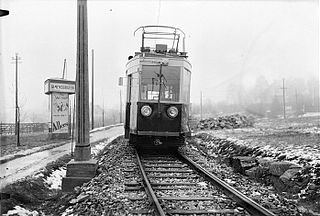
The Simensbråten Line was a light rail line of Oslo Tramway between Jomfrubråten and Simensbråten in Oslo, Norway. Opening on 30 September 1931, it branched off the Ekeberg Line at Jomfrubråten and had three stops along the 1.5-kilometer (0.9 mi) route—Ekebergparken, Smedstua and Simensbråten. Operated by Ekebergbanen, the line was closed on 29 October 1967. It is the only light rail line in Oslo to have been closed.
A/S Kristiania Sporveisselskab or KSS, nicknamed the Green Tramway, was an operator of part of the Oslo Tramway from 1875 to 1924. The company was established in 1874 and started with horsecar operations on the Ullevål Hageby Line, Gamlebyen Line and the Grünerløkka–Torshov Line. The network was electrified with in 1899 and 1900, whereby the company was bought by Union-Elektricitäts-Gesellschaft. It delivered new Class U trams. Within a few years the company had also opened the Vålerenga Line and Kampen Line. It took over Kristiania Kommunale Sporveie in 1905, taking over its fleet of Class S trams and the Sagene Ring, the Vippetangen Line and the Rodeløkka Line.

Kristiania Kommunale Sporveie or KKS, colloquially known as the Red Tramway was a municipal owned company that operated parts of the Oslo Tramway from 1899 to 1905. KKS built and operated three lines, Sagene Ring, the Rodeløkka Line and the Vippetangen Line. The three were connected by means of lines of Kristiania Sporveisselskab (KSS) and Kristiania Elektriske Sporvei (KES). KKS bought twenty motorized trams from Schuckert & Co. and twelve trailers, designated as Class S. It built two depots, Sagene and Rodeløkka.

The Flekkefjord Line is a 17.1-kilometre (10.6 mi) abandoned branch line to the Sørland Line. It ran between Sira and Flekkefjord in Agder, Norway. The only current activity on the line is tourist draisines. The station buildings along the line were designed by the architect Paul Armin Due—these have all been demolished.

The Sinsen Line is part of the Oslo Tramway on the east side of the city. Most of the line is served by line 17, although the northernmost tip (Grefsen–Torshov) is served by line 13 which otherwise runs on the Grünerløkka–Torshov Line. Both services use SL95 articulated trams.

The history of the Oslo Tramway and Oslo Metro in Oslo, Norway, starts in 1875, when Kristiania Sporveisselskab (KSS) opened two horsecar lines through the city centre. In 1894, Kristiania Elektriske Sporvei (KES) built the first electric street tramways, which ran west from the city centre. Within six years, all tramways were electric. The city council established Kristiania Kommunale Sporveie (KKS) in 1899, which built three lines before it was sold to KSS six years later. Both KSS and KES were taken over by the municipality in 1924, becoming Oslo Sporveier. The company gradually expanded the city tram network, which reached its peak length in 1939.

SM53, originally designed MBO and colloquially known as Høka, were a class of 58 trams and 50 trailers built by Høka and Hägglund for Oslo Sporveier. The units were used on the Norway's Oslo Tramway from 1952 until 2000. The 14.7-meter (48 ft) long and 2.5-meter wide trams weighed 16.9 tonnes. They had four motors providing a combined power output of 180 kilowatts (240 hp), allowing for a top speed of 60 kilometers per hour (37 mph).
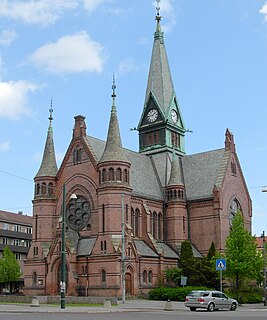
Sagene Church is located in Oslo, Norway. The church is one of the most rugged and prominent in Oslo. The church was built in gothic revival style and it was consecrated in 1891. It was designed by architect Christian Fürst in neo-Gothic style. There are 600 seats.
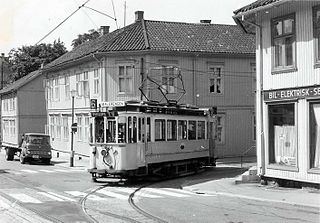
The Vålerenga Line, also known as Helsfyr Line and Etterstad Line, is an abandoned line of the Oslo Tramway of Norway. It branched from the Gamlebyen Line in Schweigaards gate and ran into the neighborhoods of Vålerenga, Etterstad and Helsfyr. The line followed the streets of Schweigaards gate, St. Halvars gate, Enebakkveien, one direction each in Vålerenggata and Strømsveien, and Etterstadgata. The line continued as a suburban light rail as the Østensjø Line and the Lambertseter Line.
Sagene Depot is a disused, but not abandoned tram depot in Stockfleths gate at Sagene in Oslo, Norway. Two hall units, several apartments and offices, a forge and a workshop constitute the depot. The two hall units are preserved, and are now used as a cultural meeting place.

Class S was a class of 20 twin-axle trams and 12 trailers built by Schuckert & Co. and Busch for Kristiania Kommunale Sporveie (KSS) in 1899. The trams were originally 7.8 meters (26 ft) long and 2.0 meters wide. They featured wooden benches in the longitudinal direction seating twenty. The motor cars had two motors providing a combined power output of 51 kilowatts (68 hp). The motor cars weighed 9.3 tonnes, while the trailers weighed 6.4 tonnes.
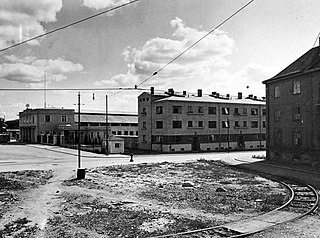
The Korsvoll Line is an abandoned line of the Oslo Tramway in Norway. The line branched off from the Sagene Line at Bentsebrugata and ran along Bergensgata to Lisa Kristoffersens plass in Korsvoll, Oslo. The line opened on 1 May 1924 and was operated by Oslo Sporveier. From 1927 it became part of Line 10, which it remained part of until its closing on 17 January 1949. The reason for closing the line was that it was amongst the least trafficked lines of the tramway and Oslo Sporveier wanted to convert it to a trolleybus line.
















